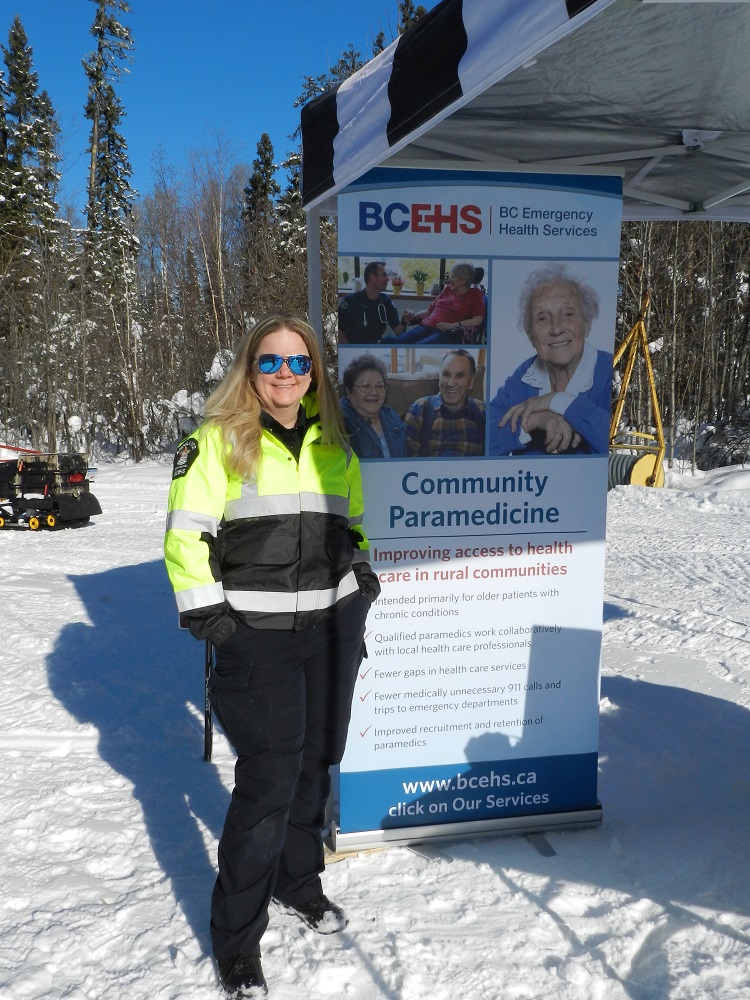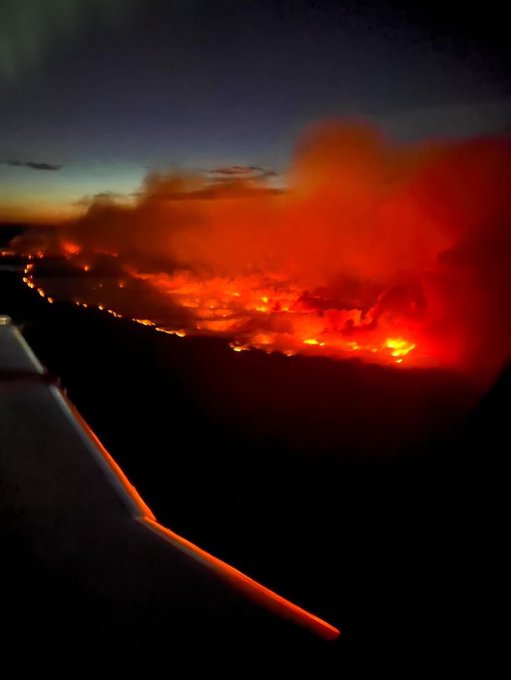Lee Cook's work and leadership as a community paramedic plays a particularly crucial role because Fort Nelson is located in the corner of northeastern B.C., a region that is both vast and isolated from major population centres.
Lee Cook didn’t start her working life as a paramedic. Originally from Whitehorse in the Yukon, Lee owned a fitness business and worked as a personal trainer and health coach, travelling to communities around the Yukon to teach fitness and train new instructors.
After twenty years in the fitness industry, however, she’d started to feel like she was ready for a change.
“I got to the point where I wanted to do more for people,” she says. “I was helping people look better but I didn’t feel like I was really making a difference in their lives.”
When she met her future husband – a career paramedic who is now an area manager at BCEHS – she realized that paramedicine would allow her to help others and make meaningful changes in her community. She started as a driver-only, then became licensed as a primary care paramedic, and then moved into her current role as the community paramedic in Fort Nelson.
“I feel like it combines my old life with my new life,” she says of her role as a community paramedic. “I’m able to be integrated in the community and have one-on-one clients and coach them, which is what I really love to do, and be a paramedic at the same time.”
Lee’s work and leadership as a community paramedic plays a particularly crucial role because Fort Nelson is located in the corner of northeastern B.C., a region that is both vast and isolated from major population centres. The Northern Rockies Regional Municipality covers roughly 13 per cent of B.C. but has a population of fewer than 5,000 people. The area is known for beautiful northern lights and abundant wildlife, but its geographical isolation can make it more challenging for residents to access health-care services.
Rather than focus on responding to emergencies, community paramedics work to prevent 911 calls from happening in the first place. There are currently community paramedic positions serving 101 communities across B.C., primarily in rural and remote locations, although there is also
an urban community paramedic clinic pilot project in Surrey.
As a community paramedic, Lee makes home visits to patients who have serious chronic health conditions such as diabetes, or congestive heart failure, or who are receiving palliative care. She does health checkups and helps educate patients on managing their conditions.
“We may not be going to all the high acuity calls,” Lee says, “but we’re there every single day seeing patients and coordinating with physicians and the health-care team. We’re kind of their eyes in the patient’s homes so they can make changes to care as needed.”
 Lee’s work also includes community outreach and education. She’s led diabetes clinics, fall prevention classes for seniors and naloxone trainings. She also offers group clinics where she checks people’s vital signs at every seniors’ home in town and at a local recreation centre, where members of the community can also come to socialize and enjoy food and coffee donated by local businesses.
Lee’s work also includes community outreach and education. She’s led diabetes clinics, fall prevention classes for seniors and naloxone trainings. She also offers group clinics where she checks people’s vital signs at every seniors’ home in town and at a local recreation centre, where members of the community can also come to socialize and enjoy food and coffee donated by local businesses.
“I love community outreach because it reaches a lot of people at once,” she says. “Any gaps I see in the community, that’s what I try to fill.”
As part of her work supporting Fort Nelson, Lee has also taken on local leadership roles. She’s a member of the community health planning steering committee and co-chair of the harm reduction committee.
One of the things Lee loves most about her work is building ongoing relationships with patients, an opportunity paramedics typically don’t have when working in emergency response.
“We get to spend a lot of time with our clients, as much as we want, and really make a difference in their lives,” she says.
The connection Lee has with her clients is one of the best parts about her job, and also one of the most challenging, as many of the people she works with are approaching end of life.
“Many of our clients are elderly and have serious chronic conditions, and we know they’re not going to live forever,” she says. “We’re aiding them on that journey. Not just them but their family members.”
“It’s never easy to lose a patient when you’ve visited them every single week for months or years” Lee says. “When they do pass, it’s difficult because you’ve built that connection with them and their family members.”
As challenging as this work can be, Lee knows how much it means to patients she supports and their families.
“The family members especially I know really appreciate the support and just having someone to call if they’re concerned about their loved one,” she says. “I know my community tells me how much this works means often, even if it’s just in passing at the grocery store.”
This year, Lee’s work was recognized by her peers at BCEHS when she received the Tony Sunderland Plaque, which is given annually to an employee in recognition of their dedication and loyalty to BCEHS and a strong commitment to the needs of their community. The award is named in memory of Tony Sunderland, a 41-year-old paramedic who died of a heart attack while attending to two critical patients at a motor vehicle accident in June 1988. He was the first BCEHS paramedic to die on duty.
Lee was nominated by Jonathan Brnjas, clinical operations manager of the Northeast District. He wrote in his nomination, “Lee Cook really puts the community into her role of community paramedic. I had the privilege of spending a shift riding along with her recently and was blown away by the community mindfulness in everything she does.”
Lee was at home when she received the call that she’d won from BCEHS Chief Operations Officer Jennie Helmer and she was so surprised she was speechless. She also realized her husband had known she’d won for some time due to his role at BCEHS and had managed to keep it a secret so that she’d get to find out from Jennie.
Lee received in her plaque in person at the BCEHS Leaders Forum in Kelowna in April.
“It was pretty awesome because I got to be in front of my peers,” she said.
 Only a few weeks after receiving her award, Lee’s life and work were upended by a wildfire that threatened Fort Nelson and led to the evacuation of the community including the hospital and residential care home. As is often the case for paramedics and other frontline workers during natural disasters, Lee had to support her community during a devastating and frightening situation, while also having to evacuate her own home.
Only a few weeks after receiving her award, Lee’s life and work were upended by a wildfire that threatened Fort Nelson and led to the evacuation of the community including the hospital and residential care home. As is often the case for paramedics and other frontline workers during natural disasters, Lee had to support her community during a devastating and frightening situation, while also having to evacuate her own home.
Lee first learned about the fire during the regular Friday afternoon knit and crochet group she leads for seniors in the community. Her husband went to check out the scene of the fire, which was only about eight miles from their home.
“Within 10 minutes of him getting out there, he messaged me and said, ‘you need to evacuate the house,’” Lee related.
In addition to her role as Fort Nelson’s community paramedic, Lee is also currently the acting unit chief. After packing up some personal items from her home, she headed to the ambulance station and started calling employees to see if they were available to help with the evacuation of hospital patients. Next, she went to hospital and started working with staff to determine how many patients would need to be moved and whether they were well enough to go by bus or would need to be moved by ground or air ambulance.
Lee and her colleagues were also looking out for vulnerable older members of the community who weren’t in a hospital or care home but might needed help evacuating.
“Essentially, it was organizing,” she said of the evacuation effort, “getting people to a safe location and making sure that no one was forgotten.”
Lee’s work didn’t stop once the evacuation was completed and she was safely relocated to Dawson Creek.
“With the help of our manager and the unit chief in Fort St John, I was making sure crew members were supported, making sure those who wanted to work could work, and those who didn't want to work didn’t have to, and making sure their families felt supported,” she says.
She also continued to provide support to her community paramedic clients, with the help of the local community paramedic in Dawson Creek.
Fortunately, thanks to courageous work of wildfire fighters and good luck with winds, only about ten buildings in the area burned and evacuees were able to start returning after several weeks.
Lee and her fellow first responders were some of the last people to leave Fort Nelson when the evacuation was ordered and then some of the first to return so they could help bring essential health care services back online before the rest of the community returned.
As frightening as the fires were this year, Lee was deeply impressed by how everyone in the community came together during an extraordinary challenge.
“I'm really proud of our team at Station 858 and the community, how well prepared we were and how we did such a good job as a team to take care of everyone,” she says. “It was definitely a team effort. It was amazing.”
